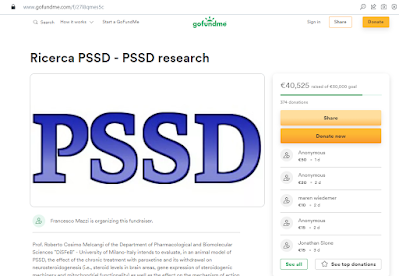Ricerca sulla PSSD del team Melcangi, Università degli Studi di Milano: aggiornamento di ottobre 2022.
La raccolta fondi (link GoFundMe) ha superato i 40mila euro e un nuovo aggiornamento è appena stato pubblicato:
Al fine di fornire un aggiornamento ai pazienti affetti da PSSD, desideriamo ricapitolare ciò che abbiamo recentemente pubblicato e che stiamo esplorando.
Le nostre precedenti osservazioni (Giatti S. et al., J.Med.Chem. 2021), ottenute in un modello sperimentale post-finasteride, hanno dimostrato che la finasteride è in grado di interagire con proteine off-target (cioè diverse dal suo bersaglio naturale). In particolare, questo farmaco è in grado di bloccare l'enzima limitante nella formazione dell'ormone dello stress, l'epinefrina (la feniletanolamina N-metiltransferasi, PNMT). Su questa base, abbiamo esplorato se anche la paroxetina fosse in grado di interagire con proteine off-targer. I dati ottenuti hanno dimostrato che anche la paroxetina è in grado di interagire con la PNMT (Giatti S. et al., J. Mol. Structure, 2022). Questa scoperta conferma ulteriormente la nostra ipotesi (Giatti S. et al., Endocrine, 2018) che PFS e PSSD possano condividere percorsi comuni. Riteniamo che questo sia estremamente importante perché può significare che la ricerca sulla PFS può essere utile per la PSSD e viceversa.
Su questa linea di pensiero, abbiamo ora esplorato se il trattamento con paroxetina, come la finasteride (Diviccaro S. et al., Psychoneuroendocrinology 2019) possa influenzare il microbiota intestinale. Come recentemente dimostrato (Diviccaro S. et al., Psychoneuroendocrinology 2022), anche la paroxetina è in grado di alterare il microbiota intestinale e la steroidogenesi nel colon. Come abbiamo proposto, queste alterazioni potrebbero essere correlate ad alcuni dei sintomi osservati nella PSSD (ad esempio, disfunzioni sessuali e disturbi dell'umore).
Stiamo continuando a studiare la PSSD nel nostro modello sperimentale, esplorando l'effetto del trattamento con paroxetina e della sua sospensione nei seguenti aspetti:
1) Identificazione di possibili geni alterati nell'ipotalamo (cioè la regione cerebrale più importante per il controllo neuroendocrino). A tale scopo stiamo utilizzando l'analisi di sequenziamento dell'RNA (un'analisi innovativa che utilizza sequenze di nuova generazione per rivelare la presenza e la quantità di RNA in un campione biologico).
2) Parametri rilevanti per la fertilità, come lo stress ossidativo, l'infiammazione, i processi di spermatogenesi, la reazione dell'acrosoma, la vitalità e la mobilità degli spermatozoi.
3) Morfologia dei nervi periferici, processo di mielinizzazione e densità delle fibre nervose intraepidermiche. In effetti, i pazienti affetti da PSSD riferiscono intorpidimento o parestesia genitale, suggerendo una neuropatia periferica. In questo contesto, è importante sottolineare che abbiamo dimostrato che i pazienti con PFS presentano neuropatia periferica (Melcangi R.C. et al., J Steroid Biom Mol Biol 2017).
4) Meccanismi patologici coinvolti nella disfunzione sessuale persistente.
Fundraising (GoFundMe link) exceeded 40,000 euros and a new update is just published:
In order to provide an update to the PSSD patients, we wish to recapitulate what we have recently published and what we are exploring.
Our previous observations (Giatti S. et al., J.Med.Chem. 2021), obtained in a post-finasteride experimental model, demonstrated that finasteride is able to interact with off-target proteins (i.e., proteins other than its natural target). In particular, this drug is able to block the limiting enzyme in the formation of the stress hormone epinephrine (i.e., phenylethanolamine N-methyltransferase, PNMT). On this basis, we have explored whether paroxetine was also able to interact with off-target proteins. Data obtained demonstrated that also paroxetine is able to interact with PNMT (Giatti S. et al., J. Mol. Structure, 2022). This finding further confirms our hypothesis (Giatti S. et al., Endocrine, 2018) that PFS and PSSD may share common pathways. We believe that this is extremely important because it can mean that research in PFS may be useful for PSSD and vice versa.
In this line of thinking, we have now explored whether paroxetine treatment, like finasteride (Diviccaro S. et al., Psychoneuroendocrinology 2019) may affect the gut microbiota. As recently demonstrated (Diviccaro S. et al., Psychoneuroendocrinology 2022), also paroxetine is able to alter gut microbiota as well as the steroidogenesis in the colon. As we proposed, these alterations may be related to some of the symptoms observed in PSSD (e.g., sexual dysfunction and mood disorder).
We are continuing to study PSSD in our experimental model, exploring the effect of paroxetine treatment and its withdrawal in the following aspects:
1) Identification of possible genes altered in the hypothalamus (i.e., the brain region more important for neuroendocrine control). To do that we are using RNA sequencing analysis (i.e., an innovative analysis that uses next-generation sequences to reveal the presence and quantity of RNA in a biological sample).
2) Parameters relevant for fertility, such as oxidative stress, inflammation, spermatogenesis processes, the acrosome reaction, viability, and mobility of spermatozoa.
3) Morphology of peripheral nerves, myelination process and intraepidermal nerve fiber density. Indeed, PSSD patients report genital numbness or paresthesia, suggesting peripheral neuropathy. In this context, it is important to highlight that we have demonstrated that PFS patients show peripheral neuropathy (Melcangi R.C. et al., J Steroid Biom Mol Biol 2017).
4) Pathological mechanisms involved in persistent sexual dysfunction.
